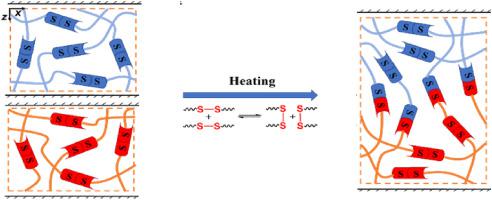Polymer ( IF 4.6 ) Pub Date : 2020-10-06 , DOI: 10.1016/j.polymer.2020.123111 Xiangrui Zheng , Hua Yang , Yaguang Sun , Yongqin Zhang , Yafang Guo

|
The self-healing polymers based on dynamic covalent bonds or non-covalent interactions have been widely reported in experiments. However, the self-healing theory and mechanism still need to be explored further. In this paper, molecular dynamics simulations are performed to investigate the self-healing mechanism based on disulfide bond exchange reactions at the atomic scale. The microstructures of sample during self-healing process are tracked, and the mechanical properties varying with healing time are examined by uniaxial tension tests. In addition, the effect of crosslink density on the self-healing efficiency and mechanical properties is investigated. The results reveal that the high crosslink density has a positive effect on the mechanical properties and a negative effect on the mobility of molecular chains. The effect of healing time on healing efficiency is also studied, which exhibits the same tendency as the experimental results. Finally, the stress relaxation test is simulated to study the dynamic feature of exchangeable disulfide bonds. The results indicate that the system with shorter stress relaxation time has higher healing efficiency.
中文翻译:

基于二硫键交换反应的自愈行为的分子动力学模拟
实验中广泛报道了基于动态共价键或非共价相互作用的自修复聚合物。但是,自我修复的理论和机制仍需进一步探索。本文通过分子动力学模拟研究了在原子尺度上基于二硫键交换反应的自愈机理。跟踪样品在自愈过程中的微观结构,并通过单轴拉伸试验检查随愈合时间变化的机械性能。另外,研究了交联密度对自修复效率和机械性能的影响。结果表明,高交联密度对机械性能有积极影响,而对分子链的迁移率则有消极影响。还研究了愈合时间对愈合效率的影响,表现出与实验结果相同的趋势。最后,通过模拟应力松弛试验来研究可交换二硫键的动力学特征。结果表明,应力松弛时间较短的系统具有较高的愈合效率。


























 京公网安备 11010802027423号
京公网安备 11010802027423号